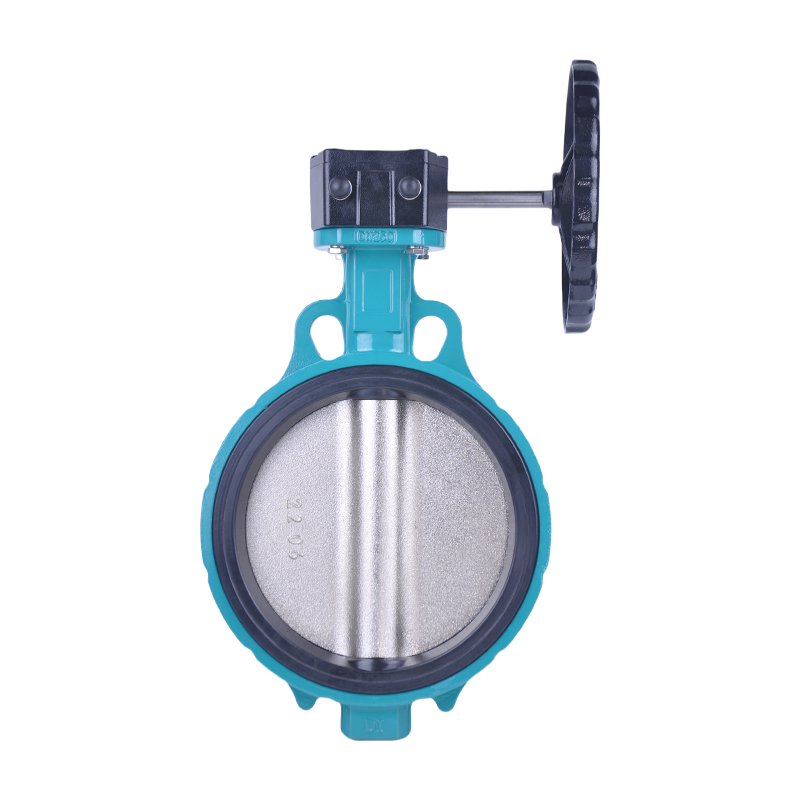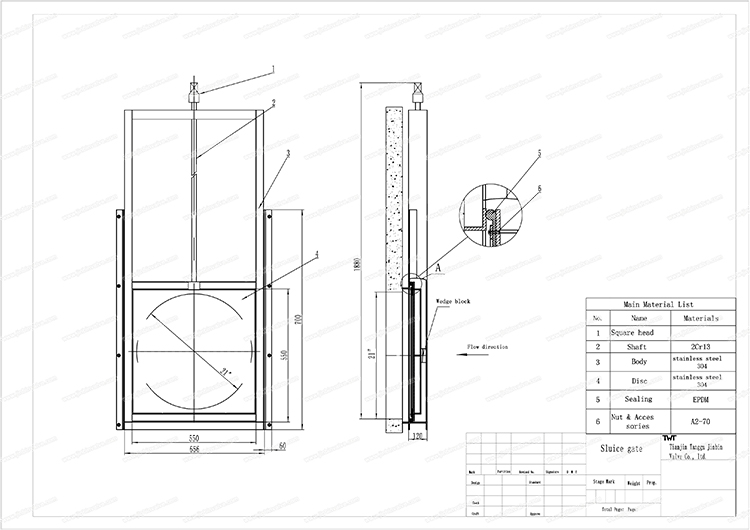Selecting the right valve could improve safety and prevent unplanned downtime
At the least, a valve should last from one planned shutdown to the next. A good valve should last for three or four shutdowns, depending on process conditions. Good valves, as one would expect, cost a little more, but longevity and dependability pay dividends compared to the low-cost alternatives. If a project planner specifies valves based on cost alone, it could spell trouble for the operation. Knife gate valve

Mines move and store tailings as an abrasive and often corrosive slurry and that process represents an inherent risk for many operations. Similarly, some mines pump considerable amounts of acidic liquids under high pressure. A valve that closes too slowly or fails to seat properly could cause turbulence in the pipeline. If a valve fails or leaks, safety could be compromised, and materials could be released into the environment.
The design of knife gate valves hasn’t changed much in years, but processing conditions have, explained Steve Clauson, director of international sales and global mining for DeZURIK. “Our valves are adapting to process conditions. Mining projects are getting larger, pressures and velocities within the pipeline are increasing and slurries contain more solids, and they are more abrasive. Our valves have been modified to meet those needs.” Clauson has more than 30 years of experience supplying knife gate valves to the mining business.
DeZURIK designs valves specifically for these mining-type applications and the company continues to redesign them to handle those types of materials, Clauson explained. “We are using overlays to withstand the brute force attack of abrasiveness, and we are doing it with sustainability in mind,” he said. “We are constantly looking at better packing options and tighter tolerances. We are trying to do our part to keep mining out of the news from an environmental standpoint.”
DeZURIK sells a lot of valve styles for many different applications. With mining, however, about 70% of what the company supplies is large knife gate valves for tailings handling applications.
As velocities and pressures increase, Clauson explained, DeZURIK is seeing more requests for knife gate valves rated at 600 and 900 psi, and even some 1,500-psi class valves. “These factors are pushing the envelope as far as valve design and even the viability of the valve’s sealing system,” he said. “So that’s why we try to steer miners toward a balanced approach.”
Fortunately, with proper engineering and the use of modern equipment, like variable speed pumps, large valves and pipelines can withstand today’s higher flowrates. When designing a slurry handling network, Clauson recommends operating at 80% of the rated capacity or less. He also said engineers should be aware of what future capacity might look like when selecting valves.
If it’s possible, Clauson recommends that mines track data on valve performance and lifespan, provide that information to the project design teams. Oftentimes, project planners do not know the proper valve to specify. The project gets commissioned and then it becomes a problem for maintenance when the issue could have been avoided entirely.
Information is critical and engineers and project planners need to know the questions to ask, Clauson explained. Why is the valve failing? What is the nature of the failure? How often is maintenance scheduled? What is the cleaning process? Is it a lined pipeline? What is the inside diameter (ID)?
“Miners will contact us and say they want to purchase one of our valves because the ones they are using are failing,” Clauson said. “That’s where we dig in and try to solve the problem by determining the nature of the failure instead of just replacing a valve and expecting a different result.”
The weakest link for a knife gate valve is the packing. “The valve has a large gate and a large surface area that has to seal,” Clauson said. “We pay close attention to the packing system, and we make sure it can handle the pressure and provide good service life. Bonnets can be used on a valve with high cycle times, or a lantern ring style of packing could be used instead of the rope style packing.”
Sometimes the cleaning process can cause the problem. Some mines flush the lines with diesel fuel or chemicals. Others will use steam to clean lines. These processes can cause temperature or chemical compatibility problems with the elastomers used in the valves. “A mine may have selected the perfect valve for the operation, but the cleaning process destroys the integrity,” Clauson said.
Because slurries are so abrasive, some mines will rotate the pipeline a quarter turn every six months because of wear along the bottom, but they forget to take the time to turn the rings in the valve. “It’s also important to configure the valve to match the ID to maintain laminar flow,” Clauson said. “Turbulent flow reduces the service life of the valve and impacts the performance of the pipeline.”
Maintenance is usually scheduled around plant outages. “One supplier might say their valve lasts 15% longer than another, but that doesn’t matter if it doesn’t make it to the next outage,” Clauson said. “The prudent decision is to make a step change in performance and increase the life to the point where maintenance can skip one or two outages and make it comfortably to the next one.”
Understanding flow dynamics and having the tools to assess it, like finite element analysis, helps immensely in designing a pumping system. With a knife gate valve, the operator should try to close the valve quickly, but not too quickly, Clauson explained. “As that blade comes down and it’s within 10% or 15% of the seating area, the velocity of the slurry is increasing exponentially,” he said. “With abrasive slurries, that’s the kill zone. The flow dynamics are really destructive at that point. Closing the valve too quickly, however, could create water hammer in the line and that can be even more devastating.
DeZURIK has products that offer long-term savings, but the project engineers need to see the value in purchasing a product that costs 20% to 40% more than the lighter-duty options. The company has a portfolio of knife gate valves, but the two valves geared toward mining applications are the KUL line of urethane-lined knife-gate valves and the severe-service KSV line. “I’ll stack that valve up against anyone else,” Clauson said.
A pnuematic actuator mounted on this Delta Industrial knife gate valve ensures slurry isolation. (Photo: Weir)
Nickel and cobalt are in high demand these days and they are typically extracted from laterite ore bodies using a high-pressure acid leach (HPAL) process. The HPAL process combines high temperatures, with elevated pressure and sulphuric acid to separate the nickel and cobalt from the laterite ore, explained John Abbott, global product manager-valves for Weir. “This presents several operational challenges and, from a safety and environmental perspective, it’s imperative that personnel aren’t exposed to the highly corrosive slurry when carrying out maintenance,” he said.
To reduce this risk, a mining company approached Weir to develop an automated valve solution to replace the spectacle blinds it was using to isolate equipment during maintenance and shutdowns.
Every two weeks, the maintenance shutdown required three hours for the site technicians to physically unbolt the spectacle blinds and move them to the closed positions.
Any safety incident with the 2.5 pH acidic slurry at 27 bar pressure and at temperatures that can reach up to 169°C would cause serious harm to the people and the environment, Abbott explained.
After a detailed analysis of the process and running custom ferroxyl tests for iron contamination, Weir engineers recommended installing Delta Industrial DN 400 (16-in.) and DN300 (12-in.) pneumatically actuated knife gate valves with a Grade 12 titanium body and gates. “The pneumatic actuators ensure a 100% slurry isolation each time, up to a maximum operating pressure of 51 bar,” Abbott said.
The valves have operated maintenance-free for four years, Abbott explained. “As a result, the safety risk related to the possibility of acid slurry leaks has been significantly reduced,” he said. “With full automation, plant operators can now isolate the area in less than a minute, a significant improvement from the three hours previously required for manual operation of the spectacle blinds. This has saved the site 72 maintenance hours per year.”
Delta Industrial knife gate valves are designed to excel in heavy-duty applications, Abbott explained. “The primary resilient seal provides zero leakage, guaranteed sealing, while the secondary metal seat is engineered to an exacting tolerance to ensure the blade and metal seat provide maximum shut off,” Abbott said. “This not only acts as a secondary backup, but it also prevents over compression of the resilient seal. With some valves, operators can ‘over close’ them, which causes over compression of the seals. This is impossible with Delta Industrial valves because the valve comes to a complete rest against the metal seat, which stops the resilient O-ring from being crushed.”
In HPAL applications, Weir metallurgists analyze the application to ensure the materials can handle the high temperature and pressures, as well as the acidic slurry. The longevity and reliability of the valves are obviously contingent on this selection, Abbott explained.

Blast Furnace Valve We use cookies to enhance your browsing experience, serve personalized ads or content, and analyze our traffic. By clicking "Accept All", you consent to our use of cookies. Not consenting or withdrawing consent, may adversely affect certain features and functions.To provide the best experiences, we use technologies like cookies to store and/or access device information. Consenting to these technologies will allow us to process data such as browsing behavior or unique IDs on this site. Not consenting or withdrawing consent, may adversely affect certain features and functions.